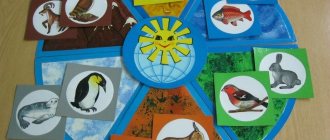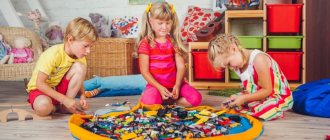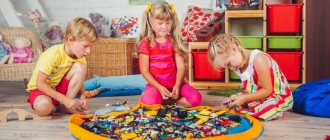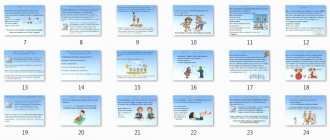Games with sand for children 3-4 years old in kindergarten. Card file with goals
Card index of games with sand for preschoolers
Junior group
The sand play library combines games aimed at general relaxation, relieving hyperactivity, developing perseverance and patience, increasing concentration, developing logic, thinking and speech.
These games stabilize the emotional state of children, along with the development of tactile-kinesthetic sensitivity and fine motor skills, teach the child to listen to himself and articulate his feelings, which is important for the development of speech, voluntary attention and memory. It is important that these games open up the child’s potential, developing his creativity and imagination. Playing with sand is a natural and accessible form of activity for every child. A child, including those with special developmental needs, often cannot express his feelings and fears in words, and here games with sand come to his aid. By acting out the situations that agitated him with the help of toy figures, creating a picture of his own world from sand, the child is freed from tension. And most importantly, he gains invaluable experience in symbolically resolving many life situations. Hello, sand Goal: reducing psychophysical stress. Progress of the game: The teacher-psychologist asks to “say hello to the sand” in different ways, that is, to touch the sand in different ways. The child: • touches the sand alternately with the fingers of one, then the other hand, then with all fingers at the same time; • easily/with tension squeezes sand into fists, then slowly pours it into the sandbox; • touches the sand with the entire palm - the inside, then the back; • rubs sand between fingers and palms. In the latter case, you can hide a small flat toy in the sand: “One of the inhabitants of the sand or its owner wanted to say hello to you...” Children of older preschool age describe and compare their sensations: “warm - cold”, “pleasant - unpleasant”, “prickly , rough”, etc. Sand rain Purpose: reducing psychophysical stress, developing attention and imagination. Progress of the game: A teacher-psychologist in a fairy-tale land may experience an unusual rain of sand and a sandy wind blowing. It is very nice. You can make such rain and wind yourself. Watch it happen. The child slowly and then quickly pours sand from his fist into the sandbox, onto the palm of an adult, into his palm. The child closes his eyes and places his palm with his fingers spread out on the sand, the adult sprinkles sand on a finger, and the child names this finger. Then they change roles. Who walks along the stitch Goal: development of tactile sensitivity, imagination, fine motor skills. Progress of the game: “The bear cubs are coming” - the child presses forcefully onto the sand with his fists and palms. “Hares are jumping” - the child hits the surface of the sand with his fingertips, moving in different directions. “Snakes are crawling” - the child, with relaxed/tense fingers, makes the surface of the sand wavy (in different directions). “Spiderbugs are running” - the child moves all his fingers, imitating the movement of insects (you can completely immerse your hands in the sand, meeting each other with your hands under the sand - “bugs say hello”). “Crocazyable” - children leave a wide variety of traces in the sand, come up with a name for the fantastic animal that left such traces (later this animal can be drawn and made it an inhabitant of the sand country). Secret tasks of moles Goal: development of tactile sensitivity, imagination, attention, fine motor skills. Progress of the game: Teacher-psychologist. Today our hands can turn into moles. Like this. (The adult waves his hands and folds them like a duck, showing the child the eyes, nose and two teeth drawn on his knuckles.) Do you want to turn your hands into moles? I need to help my mole complete an important secret mission underground. (At the child’s request, the adult carefully draws a nose and eyes on the child’s knuckles). Are we sinking into the sand? Look and do like my mole. The adult plunges one hand into the sand, moves it under the sand (draws the child's attention to changes in the surface of the sand), and then carefully digs out each finger. Then the child does the same. After that, they dig out each other’s hands (you can blow on the sand, use a feather, sticks, brushes). Option: carry out all actions with your eyes closed - look for each other’s fingers in the sand, shake them (the moles greet each other affectionately or shake each other’s paws forcefully). Prints Goal: development of tactile sensitivity, visual perception, voluntary behavior of fine motor skills, orientation in space. Progress of the game : The teacher-psychologist and the child take turns making prints in the sand. Then the child, following verbal instructions or a plan drawn by an adult, makes a series of prints, commenting on the process. In such games, you can use tasks to classify objects, for example - only geometric shapes, only animals. Hide and seek Goal: development of tactile sensitivity, visual perception, imaginative thinking, voluntary behavior, fine motor skills. Progress of the game (first option)
: Educational psychologist.
The toys want to play sand hide and seek with you. Choose the toys you like. You close your eyes, and they will hide in the sand, and after I say: “The eyes open, the game begins,” you must find them in the sand. You can blow sand, dig with your fingers, use sticks, brushes. To diversify the game, the adult shows the child a toy - a “mine” that cannot be completely dug out. As soon as part of it appears on the surface of the sand during excavation, the child must stop his excavations and continue them in another place. If a child forgets a rule, he will receive a game penalty, so he will be forced to dig out the toys very carefully. Progress of the game (second option)
: To play, you need to have laminated pictures from different fairy tales and fairy-tale characters; you can make them yourself by wrapping bright pictures from children's books with tape.
For games with children, use color pictures with a clear image (at the initial stage - easy to understand, depicting one object). To develop search activity, the image becomes gradually more complex. So, for older preschoolers, the image can be black and white, silhouette. First, the adult talks with the child about his favorite fairy tales and heroes, about the reasons for positive and negative attitudes towards different heroes. Educational psychologist. Fairy tales and fairy-tale heroes love to hide in the sand. Close your eyes and say the magic words: “One, two, three, fairy tale come.” (An adult buries a picture from a fairy tale well known to the child in the sand. For kids, leave a corner of the picture visible.) Take a brush and start looking for this fairy tale in the sand. To avoid frightening the tale, unearth it slowly and carefully. You cleared away the sand from part of the picture: what kind of fairy tale do you think this is? The child gradually opens the picture, at some stage he is able to name a fairy tale or a fairy-tale character. Sand builders Goal: development of perception, spatial concepts, auditory and visual memory. Progress of the game: Teacher-psychologist. The inhabitants of the sand country ask you to help them build houses. First, we need to mark in the sand where this or that house will be built. For example, a bun likes only round houses, a wolf only likes rectangular ones, and a fox wants to live in a square house. Help the inhabitants of the sandbox. A fox will live in the upper right corner. Select the desired mold and make an imprint. The child resettles all the inhabitants of the sandbox. The game can be complicated by introducing more characters and distributing toys according to a plan drawn by an adult. Who came to visit us? Goal: development of visual and tactile perception, attention, memory, fine motor skills. Progress of the game: The child turns away, the adult makes bas-relief/high-relief prints using molds, then the child guesses the mold that the adult used. Then they change roles. The molds are first inspected and felt, and their contours are outlined. To complicate the task, play with new molds without first feeling them. Patterns in the sand Goal: development of visual and tactile perception, attention, memory, fine motor skills. Progress of the game: The teacher-psychologist, using the edge of his palm, with a brush in the upper part of the sandbox, draws various geometric shapes (in accordance with age standards for development), simple/complex patterns (straight and wavy paths, fences, ladders). The child must draw the same pattern below in the sand, or continue the adult’s pattern. Option: an adult draws on an interactive whiteboard and gives verbal instructions to draw a specific pattern in the sand. The same patterns on sand are made by laying out objects in a given sequence, for example, pebbles, acorns, large buttons, etc. Teacher-psychologist. Today you and I will decorate our sand house. See what patterns you can draw in the sand. Draw like me. Come up with your own pattern, drawing. There will be patterns of circles at the top of the sandbox, and triangles at the bottom. Beads for Aksinya Purpose: development of visual and tactile perception, attention, memory, fine motor skills. Progress of the game: Teacher-psychologist. The Russian beauty Aksinya's beads broke. She is very upset and crying. Shall we help her make beads? The child draws a circle on the sand using any means and decorates it with various objects: pebbles, seeds, buttons, coins, beads. The child can give the resulting beads a name. Conqueror of anger Goal: relieving nervous and mental tension, developing the ability to cope with anger. Progress of the game: Teacher-psychologist. Today we will talk about mood. What is it like for you? What happens to you when you are angry, angry? What do adults say and do when you are angry? (Child's answers.) Your angry mood makes you do and say different things that make adults angry and upset. And after the anger has gone, you feel sad or unpleasant. I’ll tell you a secret - every big and small person has the right to be angry. There are many games that teach us to “get angry the right way,” that is, in a way that doesn’t offend others. Sand will give you one of these games. See how you can use sand to sculpt and see your own anger, and then defeat it. (If the child’s tension is too great, then in this case you can ask him to squeeze the sand forcefully, compact the surface of the sand with his fists, etc.) The child, following the example of an adult, makes a ball out of sand, on which he marks with indentations or draws eyes, nose, mouth: “B Your anger now lives in this ball.” This process temporarily switches the child, and the child also transfers his negative feelings and guilt for “bad behavior, thoughts, feelings” to the sculpted ball. An older preschooler can comment on the entire process of making the “evil ball,” to which all evil thoughts and actions are ultimately assigned. Then the child destroys the sand ball in any way, saying a magic spell: “Drive away anger, invite joy.” The baby provides an outlet for aggression, which usually appears when it is prohibited and controlled by an adult; he also receives specific pleasure from destruction. After this, the child slowly levels the surface of the sand with his hands and leaves imprints of his palms on it - calming, gaining balance and control over his own feelings: “I conquered my anger. I am calm". If desired, the child can decorate their handprints in the sand. Mouse holes Purpose: Development of thinking, imagination, fine motor skills. Progress of the game: The child, together with an adult, digs small holes - minks with their hands or a shovel. Then the teacher plays out the construction with the help of a toy. For example, a teacher takes a toy mouse in his hands, imitating its squeak. Then her little mouse sneaks into each hole and praises the child for making wonderful houses for her. Houses can also be made for other toys - bunnies, foxes, bear cubs, etc. Circles Purpose: Development of thinking and motor skills. Progress of the game: The child “bakes” various products from sand (buns, pies, cakes). To do this, the baby can use a variety of molds, pouring sand into them, compacting them with his hand or a scoop. You can also “bake” pies with your hands, transferring wet sand from one palm to another. Then the child “treats” mom, dad, and dolls with pies. Magic Goal: development of tactile sensitivity, auditory memory, voluntary behavior. Progress of the game: Teacher-psychologist. Today you are turning into a little wizard, but even magic doesn’t happen just like that. Now the Sand Fairy will conjure the forest, she will say the magic words: “Firs, birches, boletus trees.” You must close your eyes and wait a little, just don’t open your eyes without permission. (The child closes his eyes, the teacher silently plants the sand with toy trees, flowers, mushrooms.) Open your eyes and look - how beautiful and interesting she did it! The fairy has wonderful helpers - fingers (the teacher squeezes and unclenches his fingers, “walks” through the sand with them, digs holes, the child does the same). Ask your fingers to help you in witchcraft. Now you say the same magic words as the fairy and conjure another forest. What animals live in the forest? Invite them into your forest. If the child reproduces the “magic words” incorrectly, the adult hides some of the toys and repeats the words again. After “planting the forest,” the adult can introduce a few additional words related to the plot for memorization. We are going to visit Goal: development of spatial concepts, development of tactile sensitivity. Progress of the game: The teacher-psychologist in a playful way introduces the child to spatial concepts (or consolidates knowledge): “top - bottom”, “right - left”, “above - below”, “from behind - from under”, “center” , corner". The child, according to the adult’s verbal instructions, “walks, jumps, crawls” on the sand with his fingers, depicting various characters. Educational psychologist. We are going to visit the bunny. Where does the hare live? (The hare lives in the forest because it is a wild animal.) In which corner of the sandbox does the forest grow? (Kids answer “at the top of the sandbox.”) Who lives next to the bunny? (Figures or pictures of wild animals are listed and placed in the sandbox.) Who is the bunny’s friends? Who is the bunny afraid of? What did the hare treat us with? What do we wish for the bunny? The game-tasks “Let’s go to visit the horse” (consolidating knowledge about domestic animals and their housing), “Swimming towards the dolphins” (consolidating knowledge about the inhabitants of the seas and rivers), etc. are performed in a similar way. Guess the riddle Goal: Development of thinking and fine motor skills. Progress of the game: The teacher-psychologist makes a riddle, the child guesses it, and the answer is buried in the sandbox. Having dug up what is hidden, he checks the correctness of the answer. Colored fences Purpose: Development of sensory perception of fine motor skills in children. How to play: Counting sticks of different colors are placed alternately on the table. The adult asks the child to choose blue sticks from them and build a blue fence. Then use red sticks and build a red fence. You can invite your child to build one large fence, alternating sticks by color. Whether in the garden or in the vegetable garden Purpose: Familiarization with the outside world, development of thinking, speech, fine motor skills. Progress of the game: With a wave of the magic wand, the left side of the sandbox turns into an orchard, the right side into a vegetable garden. Children are encouraged to plant a garden and vegetable garden. After completing the task, the children tell what grows where. An adult asks the child to describe vegetables and fruits by shape, color, size. Forest lands Goal: Development of memory, attention, ability to classify objects according to given characteristics. Progress of the game: The child is invited to build forest land in the sandbox and populate it with wild animals living in our region. He selects only wild animals from a variety of figurines and builds a sand picture. The adult invites the child to remember all the animals that he placed in the forest. The child turns away, and at this time the adult removes one animal. The child turns around and says who is missing. Using the same principle, you can turn a sandbox into a wonderful orchard, a field with flowers, a vegetable garden, a house with furniture, etc. Back to the past Goal: Development of imaginative thinking, imagination, speech. Progress of the game: The teacher-psychologist tells the history of the city. Children close their eyes, say the magic words “Crible-crable-booms”, turn into defenders of the fatherland, are transported to the past and begin to build a city - the capital of Russia. After completing the work, they talk about what happened and share their impressions. Map-scheme “My City” Purpose: To teach children to draw maps-schemes, develop thinking and imagination. Progress of the game: Children, together with a teacher-psychologist, draw a diagram map with conventional images of trees, rivers, mountains, forests, parks, lakes, roads, monuments, houses. The child builds a sand picture according to this scheme. The child is asked to turn away, and at this time the adult hides treasures in various areas. Dots are placed on the schematic map in the place where the treasures are hidden. The child turns and looks for secrets, following the schematic map. The game can be made more difficult. The child hides the secrets himself and marks their location on the map. The adult is looking for it. Traces Goal: developing the ability to count movements, sounds, objects and indicate the number of counted objects with the last spoken number. Progress of the game: The teacher-psychologist says to the child: “Look what kind of musical instrument I have. This is a triangle (tambourine, bell, etc.). You can use it to make different sounds. I will hit it, and you count how many sounds you hear. The child listens and says how many times the educational psychologist hits the triangle, shows this number on his fingers. Then he leaves traces in the sand of the tips of those fingers, with the help of which he showed the number of blows he heard.
We recommend watching:
Games with sand for children of senior preschool age Summary of experimental activities in the senior group Games with sand for children of preschool age Pedagogical project in the middle group of a preschool educational institution
Similar articles:
Outdoor games for a walk in the younger group in the summer
Games with children 3-4 years old on the street in summer
Choosing material
First of all, you need to decide on the material.
Do you have wooden boards available? Great - they make a great container for sand. Be sure to thoroughly sand the surface of the boards so that the child does not get hurt. And painting the structure in bright colors wouldn’t hurt. The main thing here is bright colors
The space allocated for the sandbox can be limited to dug-in wooden logs or simply cut down large trees. This is both original and environmentally friendly.
Stone, bricks or paving slabs will also work as fencing.
Try combining several options - it will be beautiful and convenient.
Combined sandbox - beautiful and practical
Controversy continues regarding the use of children's playgrounds. Some say that it is very harmful, others prove the absolute safety of rubber in the fresh air. If you are a supporter of the second point of view, then use this simple and universal option.
A sandbox made from a car tire is a controversial but popular idea.
You can take one large tire, paint it a bright color and fill it with sand, or you can use several small ones to construct a rubber “seven-flowered flower”, the choice is yours.
Installing protection
So, you have decided on the material, made the base, filled it with carefully sifted sand, and taken care of how to protect this very sand from rain, debris and attacks from four-legged or winged guests?
Be sure to consider options for protecting your structure. For example, you can pull out an awning from some dense, moisture-resistant material. And for wooden sandboxes it is better to make a lid - folding or removable: If your sandbox is not in the natural shade of trees, then this is the first priority. It is strictly forbidden for children to stay in the open sun for a long time even in northern latitudes, not to mention the south.
In fact, there are a lot of options for creating shadows. This can be a piece of thick fabric suspended on pegs, or a whole tent-awning installed over the sandbox. At the dacha, you can successfully use arcs from a greenhouse and stretch fabric over them - a simple and original solution.






